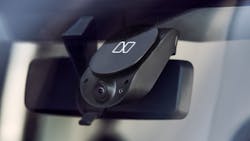With so many options in an ever-expanding market, fleets can be overwhelmed by all the distracted-driving technology options for commercial vehicles. Each solution operates at a different speed, and those fractions of a second could make a difference.
“If you’re not paying attention, and you look away at 55 miles an hour, you’ll effectively go a football field in three seconds," said Mike Yonka, director of loss control at Sentry Insurance’s transportation division and a former professional truck driver. Even if a collision is not avoided entirely, having a quick-acting solution, such as an automatic braking system, can lessen the severity of a crash and save money on repairs.
See also: Deterring distracted driving to save dollars and lives
With AI dashcams, it’s worth determining the breadth of behaviors the software can detect and the variety of situations in which it can function well. While distracted driving is typically thought of as drivers using their phones, other behaviors can increase the risk. Those risks multiply when exhibited at the same time, such as talking on the phone and eating simultaneously.
“The insurance industry in the U.S. did a study, and they found out that the No. 1 distraction is actually daydreaming," said Phil Moser, a former police officer and VP of customer development at Driving Dynamics, a provider of driver safety training.
Customizing distraction technology for your operations
Good anti-distracted driving solutions can detect a plethora of behaviors, such as smoking or turning one’s head away from the road, or even detecting when a driver is drowsy by noting posture and blink rate.
Customizability is another area where prospective buyers must think about their fleet’s needs. Managers may decide that not all driver behaviors that could be considered indicative of distraction need to be recorded, selecting a smaller array of actionable events.
If employees have privacy protections from a union, or if they operate in certain areas with applicable privacy laws, such as the California Consumer Privacy Act (CCPA) or the General Data Protection Regulation (GDPR) in the EU, the ability to pick and choose recording measures will be essential. Even something as simple as removable camera covers that drivers can use to block the dashcam lens when needed can make drivers feel more comfortable having the camera in their cab.
“We can turn audio on and off, we can do blurring, and we can do a whole host of actions to make us privacy compliant,” said Nauto chief products officer Yoav Banin. “Driver centricity, as I would call it, is a fundamental design principle for us.”
“Even though it is technically a camera, you can also think of it like an AI vision sensor," he said. "So we could be storing zero video and actually give all that real-time safety benefit. There are certain fleets that elect to not have in-cabin facing video.”
“We could still upload the metadata," Banin continued. "You know, you had a pedestrian-collision warning at this time with this distance with all the data around it without uploading any video footage, which is usually the kind of privacy concern. So we're not reliant on having that video footage up in the cloud for people to manually review to deliver the safety benefit. That's kind of the key difference, and that's because we have invested so much in real-time AI.”
Dashcams have changed trucking
The addition of AI has been a game-changer for dashcams in recent years. What was once a video recording that needed to be viewed in its entirety after an accident can now log events, such as texting or hard braking. This helps safety managers coach drivers before those bad habits lead to crashes.
“Ten years ago, you would have to sit next to the driver to help understand safety issues,” said Ingo Wiegand, senior director of product management at Samsara. “Five years ago, you would have had a telematics system with a camera, and you could record everything—and then you could watch in its entirety.”
See also: Eliminating distractions for new drivers
“I think what’s happened over the past few years is that we now can use technology to get more and more to leading indicators of risks,” Wiegand continued. “I think that really the power of the AI-enabled dash camera is that you can now go further and further back from an incident and stop or correct the behavior as it’s evolving.”
The use of AI in dashcams saves managers time because they don’t need to surveil drivers unless there is an event, and drivers could feel less like they are living under the gaze of Big Brother.
“Less than 1% of actual drive time is uploaded. The driver gets warned about anything that might get uploaded," Banin said. “Anything that the manager might know, the driver was forewarned.”
Oklahoma carrier Stevens Trucking uses Lytx, said Cole Stevens, VP of sales, because “we actually don’t have direct access to that information unless there is an actual event, and Lytx reviews all that stuff before they ever send anything to us.”
Samsara is testing another solution to protect the privacy of good drivers and allow managers to focus more on only the drivers that need more training. In-cab nudges are a way for management to give leeway to good drivers who make mistakes.
For example, a driver on a long haul drifts out of the lane. The driver will receive an in-cab nudge—an alert that allows the driver to self-coach without necessarily having an event recorded and uploaded to management. An administrator can configure the nudges to alert managers only after a predetermined number of events. This allows the driver to self-coach and saves managers time by freeing them to focus on only their highest-risk drivers.
Technology training helps drivers decrease distractions
If there’s a common theme echoed by safety experts, it’s that technologies to mitigate distracted driving shouldn’t be used as a crutch and aren’t a replacement for safety training. Any technology implemented in the cab is another technology that drivers need to be trained in.
“I think that people need to be educated on how to properly use this. ADAS [advanced driver assistance system] is not a replacement of good and safe driving habits,” Moser emphasized. “ADAS is an enhancement of safety.”
Talking to one fleet, Moser said one driver crashed because he wasn’t properly trained in his truck’s lane-departure assistance system. The driver said the wheels started vibrating, and he panicked and swerved off the road. Safety trainers must ensure drivers are aware of all their cab’s safety features if they don’t want the safety technology to become a distraction itself.
“Say the carrier sends a message out," Yonka said. "That ELD [electronic logging device] beeps, and now we have a cognitive distraction because our drivers are now thinking, ‘What do they want?' Unless it’s an emergency, I tell customers to watch what you’re doing when you’re sending out messages."
If you have multiple dispatchers or managers messaging the entire fleet, the distractions add up quickly. Yonka advises that fleets develop a procedure to mitigate that distraction, such as loading up non-emergency messages and sending them all simultaneously at the top of the hour.
Even as technology continues to progress, human error will remain unavoidable. But by knowing the needs of their fleet and drivers and investigating which solutions are the best fit, management can ensure that the roads are a little bit safer for everyone.
No cellphone, no distractions
One new technology company, NoCell, is preventing distracted driving by altogether eliminating cellphones from the conversation. A self-powered tag is attached to a truck’s driver-side windshield. When the vehicle reaches a predetermined speed, the tag, which is connected to the driver’s phone via Bluetooth, locks all apps deemed unnecessary by fleet management—typically blocking recreational apps such as YouTube or Facebook while allowing useful apps, such as truck-stop or navigational apps.
"Telematics-based solutions are good but by their nature are reactive,” according to the NoCell website. “Other solutions are training-based and effective but short-lived,” meaning drivers can easily revert to old habits like texting if they are not supervised.
See also: Hands-free wearable computer assists hands-on maintenance
If you think this technology would garner resistance from drivers, you’d be right. Corey Woinarowicz, NoCell’s chief revenue officer, said drivers are typically hesitant to have the NoCell tag installed in their cab.
“I probably talk to between 60 and 80 drivers a week, and then at all the different locations that we visit, we talk to as many drivers as possible,” Woinarowicz said, explaining that drivers express concern that NoCell will invade their privacy or track their location. Woinarowicz said NoCell collects no data on truckers, and all the data on the driver resides with the company where the driver works.
He also poses the questions to drivers: What apps do you really need? He emphasizes that those necessary apps, or even recreational apps, such as Audible or Spotify, can be whitelisted at the carrier’s discretion.
Cole Stevens uses NoCell at Stevens Trucking, saying that “it’s not just some cookie-cutter methodology for blocking apps that aren’t necessarily work-related apps because there’s a lot of GPS and truckstop apps that a driver may need to still see,” and that his drivers can still make calls using Bluetooth headsets.
Stevens said since implementing NoCell and Lytx cameras three years ago, he has seen insurance costs drop “pretty drastically.”
“If it was as easy as just putting a policy in place," Woinarowicz said, "all the hands-free laws that are in the 47 states right now would be very effective, and we would have zero crashes. But on the other hand, we had 4,132 deaths because of cellphone distracted driving in 2020.” Drivers with NoCell installed use their phone 70% less, he said.
NoCell is not only a safety tool but also a driver-retention tool, Woinarowicz said. Instead of a carrier having to fire a trucker after two or three DOT strikes, NoCell, by preventing the behavior in the first place, allows drivers to stay on the company payroll, potentially saving the carrier the $12,000 to $15,000 required to onboard a new driver.
“It's technology that got everyone into this mess, and it's going to have to take a proactive piece of technology to get people out," he added.
There is contention, however, as to whether a hands-free device is any better than speaking with a phone in hand.
“It's not the holding of the phone that's the problem; it's the conversation,” Driving Dynamics' Moser said. “Just because you're holding the phone doesn't mean it's any less or more distracting than if you had a headset,” adding that if you’re talking on the phone, handsfree or not, you're as likely to crash as a person who has a 0.08 blood alcohol concentration.
“Whether it be handheld or hands-free," Yonka of Sentry Insurance said, "the amount of milliseconds of distraction that it is—they're almost identical.”
About the Author
Scott Keith
Scott Keith is a former fleet owner digital editor, who was on staff from 2022 to 2023.





